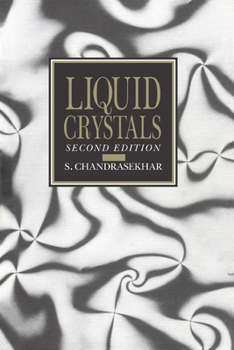Liquid Crystals
Select Format
Select Condition 
Book Overview
This is a new and greatly revised edition of Professor Chandrasekhar's classic book Liquid Crystals, first published in 1977. The subject of liquid crystals has grown into an exciting interdisciplinary research field with important practical applications. This book presents a systematic and self-contained treatment of the physics of the different types of thermotropic liquid crystals - the three classical types, nematic, cholesteric and smectic, and...
Format:Paperback
Language:English
ISBN:052142741X
ISBN13:9780521427418
Release Date:January 1993
Publisher:Cambridge University Press
Length:480 Pages
Weight:1.72 lbs.
Dimensions:0.9" x 6.1" x 9.1"
Customer Reviews
1 rating
Elegantly Written, A Little Behind
Published by Thriftbooks.com User , 16 years ago
First, S. Chandrasekhar is not THE S. Chandrasekhar, Nobel Astrophysicist, nonetheless, his classic book on liquid crystals is elegantly written, bringing to the reader's attention such beautiful words as "imbricated" (to describe nematic liquid crystal molecular positional and orientational order) and "disinclinations" (crystal defects). These words bring out the historical development of liquid crystals, which states of matter became well-known only after their use in notebook computers, mobile phones, and now in flat-panel televisions. Because of the latter, the chapters on cholesteric and smectic liquid crystals (which constitute major portions of the book) are not that interesting to persons in the display business. The science and theory development is well-expostulated, particularly the early dipole moment models, which makes the book the classic that it is. However, taken from fluid dynamics, the use of the comma subscript to denote partial differentiation in the continuum theory chapter, while certainly saving space and symbols, detracts from the meaning of the equations and forces the reader to squint to look for the commas, and I may be dense, but I still can't understand the comma after a parentheses-enclosed expression. I sometimes suspect that "insiders" like to use such terrible notation, yes partly to help in some equation flows, but also in an attempt to "exclusivise" their field so that "outsiders" have difficulty understanding it. While lack of comprehension may be a result of my own limitations, I contend that books should communicate, not obfuscate. Fluid dynamics is notorious for voluminous equations with zillions of coefficients, the end result of which is little advancement of the field and not much furtherance of physical understanding. No wonder someone once said, "the only two things I just can't understand are quantum mechanics and fluid dynamics." Chandrasekhar's treatment is science-based, but not as deeply as de Gennes & Prost, but, because written in 1977 and updated in 1992, it is a little behind the times for those who are interested in today's LCD technology.






